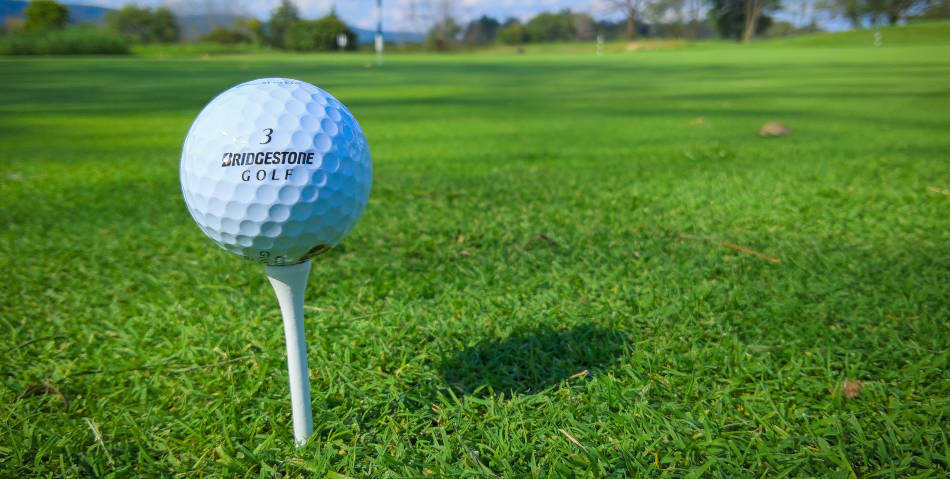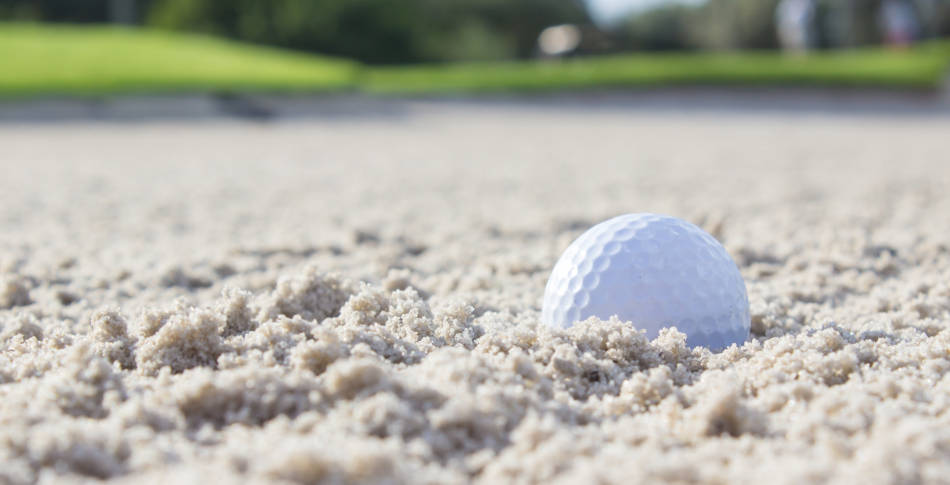
We’ve all had those moments, you finally catch your drive perfectly, watch it soar down the fairway and run out a good distance. You feel like a king among men. Then you get to your ball and it’s in a horrible lie. That’s the point you think…is it ok to just tee my ball up in the fairway and hit it again?
The answer is that, no, you cannot tee a ball up on the fairway. With very few exceptions you must play the golf ball as it lies. Of course, this applies to competition rounds but if you are playing social golf with your friends you may decide between you that you will allow the use of tees on the fairway. This is particularly helpful for newer golfers. These rounds cannot be used towards the calculation of a handicap.
What Do The Rules Say?
The rules of golf are set by two organisations – the United States Golf Association (who govern the game in North America) and the Royal & Ancient Golf Club of St Andrews (who govern the game in the rest of the world).
The rules are agreed between these two bodies so that golfers have a consistent set of laws to abide by wherever they play.
The relevant rule from the United States Golf Association in this case is Rule 13, also referred to as the Ball Played As It Lies rule.
This rule states that you are not allowed to improve the lie of the ball (where it has come to rest, such as in a divot etc), the area in which you will be swinging the club, the line the ball will be travelling down or any area in which you are dropping the ball after taking a penalty stroke.

There are a number of exceptions to this rule however.
Stance – should you ball come to rest in an area that is technically in play but requires you to take a stance where non-playable ground interferes with that stance (so in layman’s terms you’d be stood on a cart path, sprinkler head etc) you can move the ball one clubs length away, no nearer the hole.
This does mean that potentially a left handed player could get relief for something interfering with their stance where a right player wouldn’t and vice versa.
During The Backswing – if you accidentally move your ball while making your backswing and it improves your lie this is not a penalty providing you complete the stroke. If you do not complete the stroke then you will be assessed a one stroke penalty.
On The Green – once your ball is on the putting green you are allowed to repair any ground on your line (e.g. pitchmarks, spikemarks etc), as well as clear any lose debris such as leaves or gravel from your line.
On The Tee – you are allowed to repair or improve the playing area where you tee up the ball. This includes levelling off the grass, repairing any divots, removing any weeds etc.
You are also allowed to stamp down the ground in order to provide a raised area to lay the ball on – you may notice some pros do this in preference to using an actual plastic tee (although they only really do this with short irons and definitely not driver!)
Hazards – If you find yourself in a hazard, for example, a bunker, then you may clear any loose impediments out of the way of the your swing as long as you don’t move or improve the lie of the ball.
If you touch the ground while doing this it is no longer a penalty, as long as the lie of the ball is unaffected. Additionally, you are also allowed to smooth out the sand in the bunker after you have take your shot, even if you’ve failed to get out of the hazard.
Are You Allowed To Pick Your Ball Up On The Fairway?

There are certain situations where you can pick up and place your ball after it’s come to rest on the fairway. This is known as “playing preferred lies”. It’s most common in countries where the weather deteriorates over the coder, winter months.
This leads to situation where, for example, lots of mud gets attached to the ball. This can cause the ball to perform erratically and spin in an unpredictable fashion making it nearly impossible to play proper golf shots.
To prevent the game being completely ruined the rule makers provided for an exemption that would allow you to pick up your ball, clean it and place it back down in the fairway.
Normally, your national governing body will declare a set of dates for when these rules are applicable. It’s normally from the start of October through to the end of the following April.
The conditions you can use the rules under are as follows:
The ball must be in the general area (this means on the fairway or the fringes of the green – you cannot use preferred lies in the rough).
You may remove the ball, clean it and replace it within 6 inches of the of the original spot, no nearer the hole.
While this rule may be enforced generally by a national governing body, local club committees can override this if they feel it necessary and insist that you continue to play as it lies. Make sure you check the rules at your course before you tee off!
Taking Relief From An Immovable Obstruction
Sometimes, your ball will come to rest in what is called an immovable obstruction.
This can be something like temporary water (for example, if it’s been particularly wet and there is standing water on the ground that is not part of a marked hazard).
You should first assess the situation and decide if you want to take relief from the obstruction – this isn’t always a given as you’ll need to look at where you will be dropping – it might not leave you in a better position!
If you opt to take relief from the obstruction then you’re not given a penalty stroke. You must take relief from the nearest spot (no closer to the hole) so that the obstruction no longer interferes with your ability to play the shot (which includes your stance and swing).
Once you’ve found that point of relief, you can drop within one club length, no nearer to the hole. You should use the longest club in your bag to find the point you can drop but not your putter.
Do You Have To Use A Tee On The Tee Box?
The short answer is no, there’s nothing in the rules of golf that means you have to use a tee when you’re taking your first shot on each hole.
The vast majority of players will use one however as it would seem strange to turn down the opportunity to guarantee yourself a perfect lie for your ball!
Those players that decide not to use one (normally because it’s a par 3 and they feel more comfortable hitting short irons or wedges off of turf) do have the choice to knock up a bit of that turf to create a slightly raised hitting area – effectively creating a tee out of grass.
Makes you wonder why they don’t just use an actual tee in the first place!
Remember, if you do elect to use a tee and the ball falls off as you’re addressing the ball or making your swing that is NOT a penalty. You’re allowed to replace the ball, despite what some wise guy will say to you.
What If My Ball Is Plugged?

Sometimes you’ll think you’ve hit a perfect shot and get to the ball only to find it’s plugged in the fairway (in the rules of golf it’s referred to as an embedded ball).
Luckily, the rules now allow you to move the ball out of it’s depression and place it in a playable position without penalty. This does NOT apply to balls which are plugged in a bunker or other hazard however.
Previously, this rule only applied to the fairway but as of 2019 it also applies to the rough and other areas that are not closely mown.
You must make sure your ball is actually plugged before applying this rule, that means it needs to be sat in its own pitch mark and not just nestling down in the grass. If it’s the latter then sorry, you’re going to have to play it as it lies!
If you’ve determined that your ball is indeed embedded you should mark the spot directly behind the pitchmark, normally using a tee or something similar. From that point you can drop within one clubs length, no nearer the hole.
Golf Rules/Etiquette For Teeing Off
In golf, there are rules for almost every situation, including teeing off.
Normally, by convention, the player with the best score on the previous hole is said to “have the honor” and will tee off first.
There are usually several different sets of tees denoted by colored markers. You will play from the same set of colors on every hole of your round unless there is a local rule in place stating that on a certain hole you have to use a certain set of tees.
The par of the hole and the relative difficulty (defined by the stroke index) can change depending on which set of tees you use.
Once you have identified your set of tees, you must tee it up between the markers or within two club lengths of the markers going away from the hole.
You must not tee up forward of the markers – if you do then you could be hit with a two stroke penalty and be asked to play the ball again (often a common mistake in match play is someone tees up at the wrong spot, the opponent notices and waits for the player to hit their shot before calling a penalty on them).
Sometimes, you may be playing in a mixed group (with different golfers using different tees). In that case, the golfers furthest away from the hole will play first.
Exceptions To The Above
So, now you’ve read all about the different types of things you can and cannot do on the tee in a normal round of golf.
Now forget all about them and learn about Tee Golf. This is a sport designed for the recreational golf who just wants to get out and have fun on the course and not be miserable hacking his/her way around.
Essentially it’s very much like regular golf except that you use a tee with every shot. I’d highly encourage you to check out their site especially if you’re just starting the game.
In Conclusion
Golf is a fascinating sport with so many nuances, rules and conventions that players follow. Don’t let the above in depth discussion of something as simple as teeing the ball up put you off.
I’d suggest getting down to your local golf course or driving range and talking to a pro about getting started.
It’s a wonderful game that gets you out into the fresh air and lets you make friends and become part of a like minded group of people.
Let me know how you get on, happy golfing!